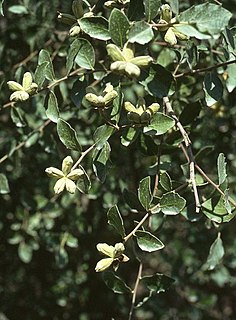
Quillaja saponaria, the soap bark tree or soapbark, is an evergreen tree in the family Quillajaceae, native to warm temperate central Chile. In Chile it occurs from 32 to 40° South Latitude approximately. Populations are found even 2000 m (6500 ft) above sea level. It can grow to 15–20 m (50–65 ft) in height. The tree has thick, dark bark; smooth, leathery, shiny, oval evergreen leaves 3–5 cm long; white star-shaped flowers 15 mm diameter borne in dense corymbs; and a dry fruit with five follicles each containing 10–20 seeds.
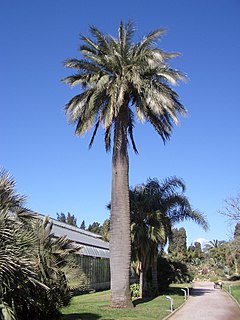
Jubaea is a genus of palms with one species, Jubaea chilensis or Jubaea spectabilis, commonly known in English as the "Chilean wine palm" or "Chile cocopalm", and "coquito" in Spanish. It is native to southwestern South America and is endemic to a small area of central Chile between 32°S and 35°S in southern Coquimbo, Valparaíso, Santiago, O'Higgins, and northern Maule regions.

La Campana National Park is located in the Cordillera de la Costa, Quillota Province, in the Valparaíso Region of Chile. La Campana National Park and the Vizcachas Mountains lie northwest of Santiago. This national park covers approximately 80 square kilometres (31 sq mi) and is home to one of the last palm forests of Jubaea chilensis, which prehistorically had a much wider distribution than at present. Another attraction is the Cerro La Campana, which lends its name to the park. In 1834 Charles Darwin climbed this mountain, during the second voyage of HMS Beagle.

Cryptocarya alba, the peumo or Chilean acorn, is an evergreen tree that grows in Chile and Argentina from 33 to 40° southern latitude. It can live both in wet and as in dry conditions. Its distribution can reach up to 1500 meters (5000 ft) above sea level. It measures up to 20 meters (65 ft) height and one meter diameter, with cracked gray bark. An associate tree is the endangered Chilean Wine Palm, Jubaea chilensis, which species prehistorically had a much wider range.
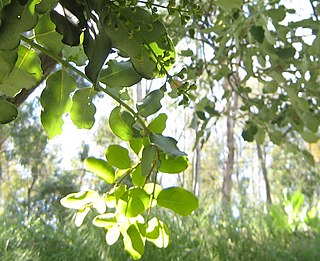
Beilschmiedia miersii, an evergreen tree in the Lauraceae native to central Chile from 30 to 35°S., up to 1200 meters (4000 ft) above sea level and lives under very dry conditions.

Paschalococos disperta, the Rapa Nui palm or Easter Island palm, formerly Jubaea disperta, was the native cocoid palm species of Easter Island. It disappeared from the pollen record circa AD 1650.

Kageneckia oblonga is a species of plant in the family Rosaceae. It is endemic to Chile. K. oblonga is an evergreen tree. It grows from Coquimbo to Malleco. Example occurrences are found specifically found in central Chile within the La Campana National Park and Cerro La Campana forest areas. In these areas the endangered Chilean Wine Palm, Jubaea chilensis is an associated tree species.

The Chilean Matorral (NT1201) is a terrestrial ecoregion of central Chile, located on the west coast of South America. It is in the Mediterranean forests, woodlands, and scrub biome, part of the Neotropical realm.
Puya coquimbensis is a species in the family Bromeliaceae. This species is a rare plant found in certain portions of Chile including Punta Teatinos and Cerro La Campana. In La Campana National Park P.coquimbensis is associated with the endangered Chilean Wine Palm, Jubaea chilensis, which palm prehistorically had a much wider distribution.

Puya venusta is a species of flowering plant in the family Bromeliaceae. This species is a rare plant found in certain portions of Chile including Punta Teatinos and Cerro La Campana. In La Campana National Park P. venusta is associated with the endangered Chilean Wine Palm, Jubaea chilensis, a palm that prehistorically had a significantly wider distribution.

Porlieria chilensis is a plant that occurs in South America. In fact, all genus members are small trees or shrubs found on the South American continent. An example occurrence of P. chilensis is in the arid forested area of central Chile, where it occurs in association with the endangered Chilean wine palm, Jubaea chilensis.
Persea meyeniana is a species of evergreen tree belonging to the laurel family, Lauraceae. It belongs to the evergreen trees genus Persea of about 150 species.
Dasyphyllum excelsum is a species of flowering plant in the family Asteraceae. Known as Bulli in Chile. This plant is known to occur in parts of South America, in Chile it occurs from Quillota to Cauquenes between 190 and 800 m above sea level, a specific location of occurrence being in central Chile within the Cerro La Campana forests in association with the endangered Chilean wine palm, Jubaea chilensis.
Cuesta La Dormida is a mountain in central Chile. Some of the forested mountain area of Cuesta La Dormida has been added to the La Campana National Park in order to achieve protection for the Chilean Wine Palm and other endangered species. Forests on Cuesta La Dormida provide habitat for a number of bird and mammal species in addition to the flora mosaic itself.
Retanilla trinervia is a species of actinorhizal plant within the family Rhamnaceae; this dicotyledon flora is a shrub or small tree. R. trinervia is notable for its ability to fix nitrogen. This species mainly occurs in the near coastal forests and arid shrubland of Chile. Example occurrences are found in the mountains of central Chile; for example, it occurs in the La Campana National Park in association with Acacia caven and Jubaea chilensis. as well as other proximate areas of central Chile.
Satureja gillesii is a plant in the family Lamiaceae. Certain organic chemicals are derived from this species, which are useful to humans. S. gillesii occurs in parts of South America, one instance being in central Chile in the La Campana National Park area, in association with the endangered Chilean wine palm, Jubaea chilensis.
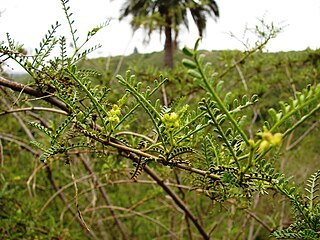
Adesmia balsamica is a rare species of flowering plant in the legume family, Fabaceae. It belongs to the sub-family Faboideae. A. balsamica is a small shrub which exudes a fragrant balsamic aroma. The species is found in portions of South America, with an example location being La Campana National Park in Chile.
Myrceugenia correifolia is a species of evergreen woody flowering shrub belonging to the Myrtle family, Myrtaceae. The common name of this plant is petrillo. The species is native to South America; an example occurrence is in central Chile within the La Campana National Park.
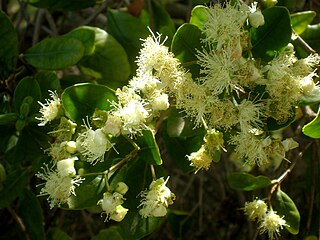
Myrceugenia exsucca is an evergreen woody flowering plant species of the Myrtle family, Myrtaceae. The species is native to South America as far south as Chile. An example occurrence is in central Chile within the La Campana National Park. A common name for this tree is petra.

Echinopsis chiloensis is a species of cactus native to South America; genus members are known as hedgehog cacti, sea-urchin cactus or Easter lily cactus.












